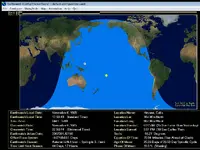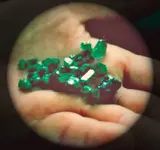Potter and Marx probably used Duro as source. Their books are good as starters, but then more serious sources need to be consulted.
Chaunu can be regarded as serious, but an exhaustive study of original documents can sometimes produce much more information. Chaunu's interest were the economics, not shipwrecks. He looked at the shipwrecks only as how far they influenced the economics.
I am considering what to do with this sketch of a reef and it's shipwrecks that I got from the fisherman. If there is no chance at all of being able to get an expedition going to check it out, I might just as well publish it on the Internet.
To be fair to everybody, I should make sure that the governments of Jamaica, Honduras, Nicaragua and Colombia all get the information simultaneously. Not to forget USA who also have a passive claim to the former guano islands. And Spain, as the owners of the galleons.
Then let's see what kind of reaction we see from form them, or should we say interaction?
Of course, the splash would be much greater if a handful of artifacts that could identify the galleons or at least date the shipwrecks very close to 1605 could be shown.
Let the shipwrecks be "preserved in situ" after the whole world knows where they are and what they carried!!!!!!!!!!!!
I think it would make a great reality show.
But, let's go back a bit to the fate full night of November 6, 1605.
At nightfall, the wind was fresh, the captain of the San Cristobal reduced a bit of sail at sunset. This was common practice. In the dark of the night to reduce sail is much more difficult, therefore, a seasoned captain would always judge the weather for the night and reduce sail if there was any doubt that the wind might get strong during the night.
What time is the sunset in the latitude of 16 degrees in November? About 17:50Hrs local time, in the year 1605.
Attached is a picture of this part of the world at sunset simulated by a cute software that can be downloaded here:
http://www.earthwatchprogram.com/download/EW403inst.zip
Sunset aboard a Spanish galleon sailing on the high seas was an event. Prayers, singing of "Ave Maria" etc. thanking God for a good day.
Pedro Chaves does not mention anything about bad weather.
The estimated position was somewhere East of the Serranilla.
They were sailing on a North-East course, with a South-East wind.
About 2 hours after dark, the fleet was hit by an extremely violent storm. The storm came from the West or North-West. The only way was to run before the wind.
The Capitana must have been in the lead, within sight of the San Cristobal. She fired a shot of warning and turned towards the South-East.
Turning around such a big, heavy ship, took probably at least 30 minutes. Some sails had to be reefed, other sails had to be taken down to make a safe maneuver.
The San Cristobal did not have the time for that. The extremely violent, sudden wind, broke the fore-masts and ripped the sails.
But the remaining rigging offered too much resistance to the wind, so that the San Cristobal healed way over and took a lot of water on board.
This situation must have lasted for some time, because the gun ports and hatches were certainly battened down well. It is probable that the breaking foremast damaged the deck and opened a way for the water to enter.
With the water having reached 18 hands, the captain decided to cut the main mast.
Before the order was executed, the wind shifted to the North. The San Cristobal righted and was blown in a southerly direction.
About 3 in the morning, the main topsail and the other sails were blown to pieces.
At dawn, the storm was over. The seas were much calmer. No other ship was in sight.
What happened to the Capitana?
The Capitana was seen by the San Cristobal at the beginning of the storm. She was further North-East than the San Cristobal, but then passed the San Cristobal, on her course to the South-East, while the San Cristobal was knocked down.
So the fleet was to the east of the Serranilla before the storm. Then the Storm blew the ships in a south_easterly direction first for a few hours, then in a southerly direction.
Which reef is to the east of Serranilla?
Enjoy
CP





 Just use a boat with lots of fishing poles out, Looks like your trolling.
Just use a boat with lots of fishing poles out, Looks like your trolling.
